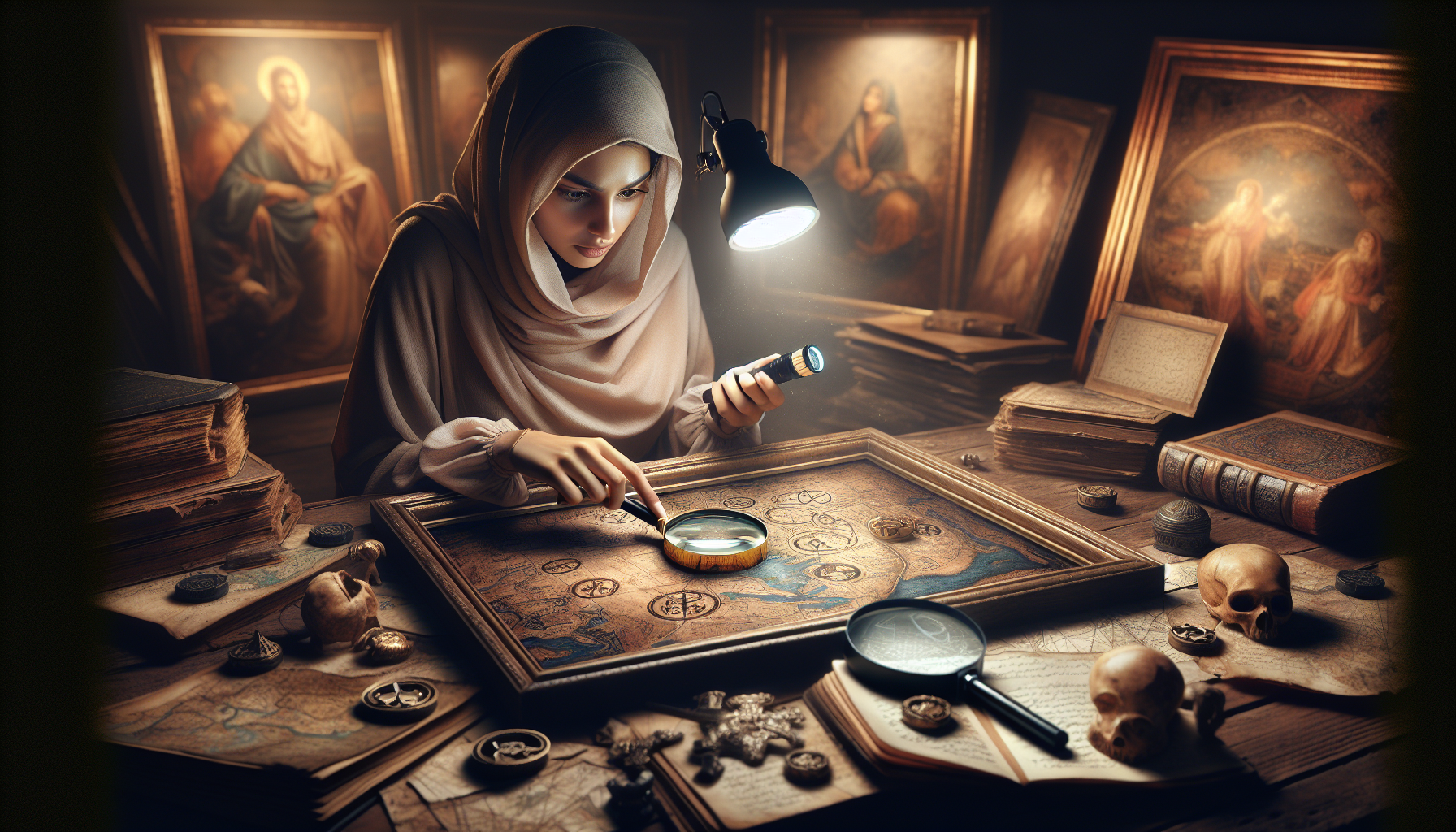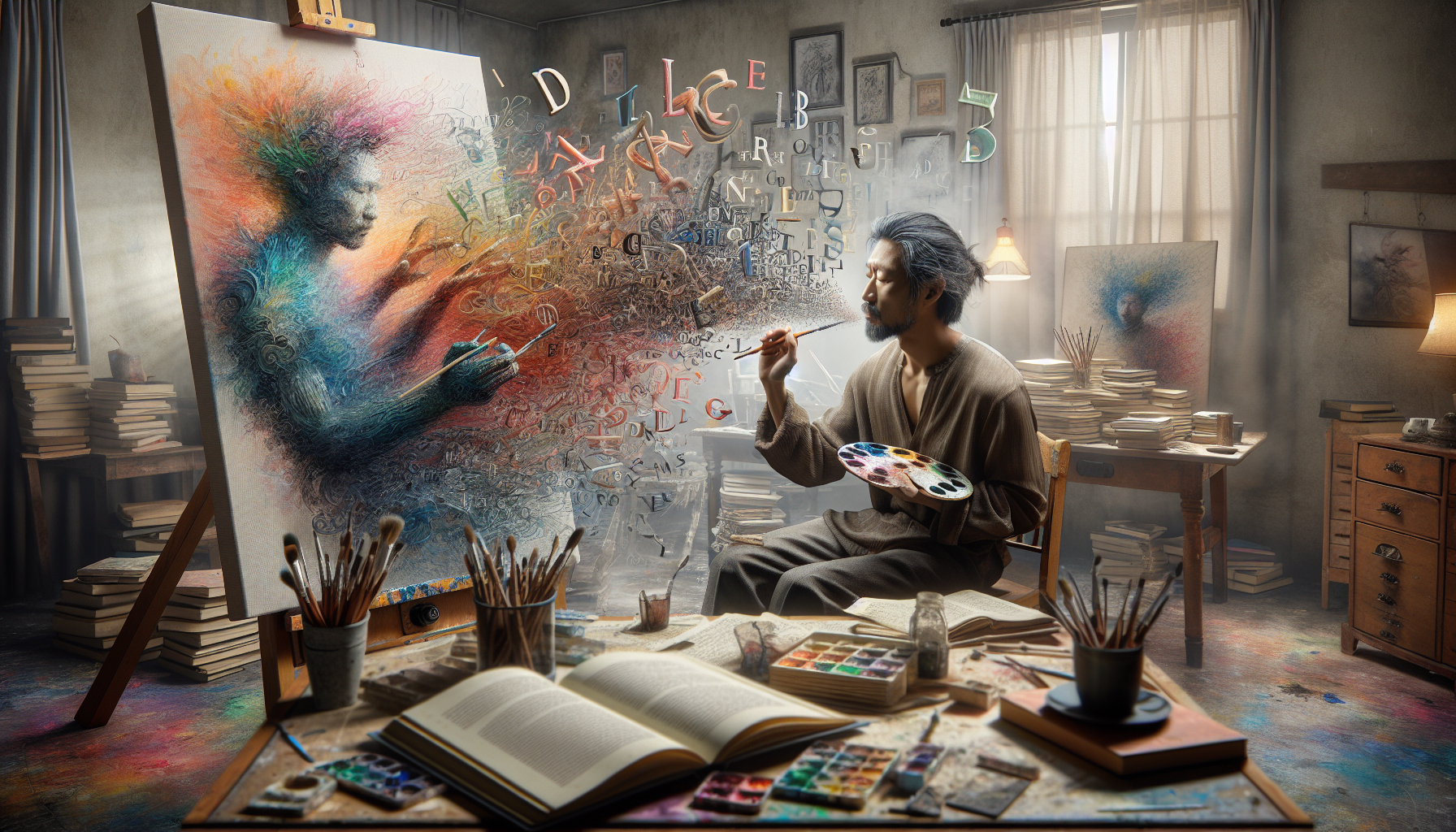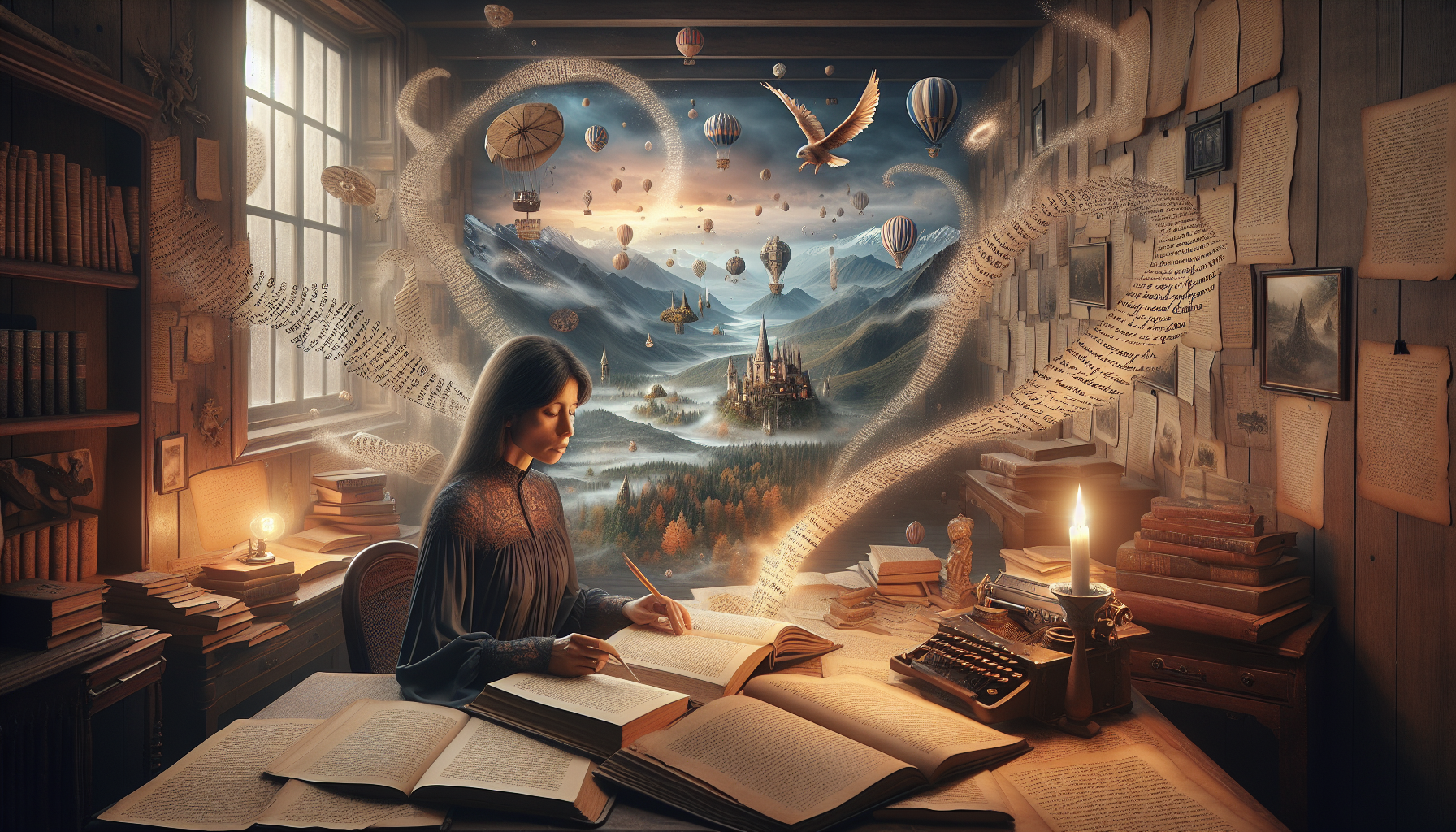Art has always been a vessel for human expression, a timeless means through which individuals and societies convey complex emotions, beliefs, and ideas. Yet, beneath the surface of vibrant colors and intricate brushstrokes lies a world of hidden symbols and secret messages, waiting to be deciphered by those curious enough to look beyond the obvious. The same can be said for maps, those seemingly straightforward tools for navigation that often encapsulate entire worldviews within their borders and legends. In this exploration, we embark on a journey to uncover the secrets locked within paintings and maps, revealing how these symbols can offer a profound understanding of the past and, perhaps, our own present. 🎨🗺️
Imagine standing before a grand painting in a dimly lit gallery, your eyes tracing the contours of the scene before you. What if I told you that the painting not only represents a moment in time but also contains a rich tapestry of symbolic language meant to convey hidden truths? From the religious iconography of the Renaissance to the subversive elements of modern art, artists have long employed symbols to speak to those who are willing to listen. Similarly, maps have been used not only as tools for navigation but as instruments of power and propaganda, embedding symbols that reflect the ambitions and biases of their creators. As we delve into this topic, we will explore how these symbols function, why they were used, and what they reveal about the cultural and historical contexts in which they were created.
Throughout this article, we will uncover the layers of meaning that these symbols hold, examining specific examples from both the world of art and cartography. We’ll look at how the allegorical paintings of the Baroque period communicated moral and philosophical ideas through intricate symbolism. We’ll delve into how medieval mappaemundi—a type of map—presented a blend of geography and theology, offering a window into the medieval mind. Moreover, we will discuss how understanding these symbols can transform our interpretation of the works, enriching our appreciation and providing insights that transcend time and place.
The Fascinating World of Hidden Symbols
Throughout history, artists and cartographers have embedded hidden symbols in their works to convey deeper meanings or messages. These symbols often reflect cultural, religious, or personal insights that might not be immediately visible to the casual observer. The practice of incorporating hidden symbols dates back to ancient times, when civilizations used visual symbols to communicate complex ideas and beliefs. In paintings, these symbols can be as subtle as a specific color choice or as overt as a clearly defined object, each adding layers of meaning to the artwork. Similarly, maps have long served not just as guides to geographical spaces, but as canvases for conveying political, religious, or social messages through carefully placed symbols.
Understanding these hidden symbols can provide a richer appreciation of the works themselves. It opens up a dialogue between the artist and the observer, allowing for interpretations that can vary depending on one’s cultural and historical perspective. For instance, in the works of Renaissance artists, symbols often related to Christian iconography, mythology, or alchemy, each holding significant meanings that would have been recognized by viewers of the time. In modern times, understanding these symbols requires a knowledge of the historical and cultural context in which they were created, as well as an awareness of the artist’s own life and beliefs.
The power of symbols lies in their ability to transcend language and communicate on a universal level. They engage the viewer’s imagination, prompting a deeper reflection on what lies beneath the surface. By unlocking these symbols, we gain not only insight into the artwork itself but also into the mindset and environment of the time in which it was created. As such, the study of hidden symbols in paintings and maps is not just an exercise in art history, but a journey into the minds and societies of those who came before us.
Hidden Symbols in Renaissance Paintings
The Renaissance period, spanning the 14th to the 17th century, was a time of great artistic, cultural, and intellectual flourishing in Europe. Artists of this era often infused their works with symbolism, blending artistic beauty with intellectual depth. This was partly due to the period’s renewed interest in classical philosophy and humanism, which encouraged artists to explore complex themes and ideas.
One of the most famous examples of hidden symbolism in Renaissance art is Leonardo da Vinci’s “The Last Supper.” The composition of the painting, the gestures of the figures, and even the placement of certain objects all convey deeper meanings. For instance, the number three, symbolizing the Holy Trinity, is repeated throughout the painting in the groupings of the apostles. Additionally, the spilled salt near Judas Iscariot is often interpreted as a bad omen, hinting at his betrayal of Christ. These elements, while not immediately obvious, add layers of narrative and theological symbolism to the artwork.
Another example is Sandro Botticelli’s “The Birth of Venus,” which is rife with classical symbolism. The painting not only depicts the mythological birth of Venus but also conveys ideas about beauty, love, and divine inspiration. The presence of the Zephyrs, godly figures of the west wind, and the Hora of spring, who is ready to cloak Venus, adds layers of meaning related to transformation and rebirth. Botticelli’s work is a prime example of how Renaissance artists used mythology to explore humanistic and philosophical ideas.
Renaissance artists also employed symbols from nature, religion, and mythology to imbue their paintings with hidden meanings. The use of certain plants, animals, and colors could convey specific ideas or themes to viewers familiar with the symbolic language of the time. For instance, lilies were often used to symbolize purity and innocence, particularly in scenes involving the Virgin Mary. Through these symbols, Renaissance paintings offer not only aesthetic beauty but also a profound intellectual experience for those who take the time to uncover their hidden meanings.
Comparative Table of Symbols in Renaissance Art
| Symbol | Common Meaning | Example in Art |
|---|---|---|
| Lily | Purity, Virginity | The Annunciation by Leonardo da Vinci |
| Apple | Temptation, Sin | Adam and Eve by Lucas Cranach the Elder |
| Skull | Mortality, Vanity | Saint Jerome in His Study by Albrecht Dürer |
To explore more about hidden symbols in Renaissance art, watch this insightful video: The Hidden Symbols in Renaissance Art by the Smarthistory channel. 🎨
Decoding Symbols in Historical Maps
Maps are not only tools for navigation but also historical documents that can reveal much about the cultures and societies that produced them. Like paintings, maps often contain hidden symbols that convey messages beyond their apparent function. These symbols can reflect the political, religious, and social ideologies of their creators, providing insights into the worldview of past societies.
During the Age of Exploration, European maps were rich with symbols that conveyed power and territorial claims. Sea monsters, for instance, were often depicted on the edges of maps to symbolize the unknown dangers of uncharted territories. These mythical creatures served as both a warning and a reminder of the mysterious and expansive nature of the world. The presence of certain symbols on maps also indicated political alliances and territorial aspirations, with royal coats of arms often marking claimed lands.
Religious symbols were also prevalent in historical maps, especially during periods of religious conflict and expansion. The use of crosses, for instance, often marked territories as part of the Christian world. This practice was particularly common during the Crusades when maps were used not just for navigation but as propaganda tools to rally support for religious campaigns. Similarly, Islamic cartographers used the crescent and other symbols to denote Islamic territories, indicating the religious influence in map-making.
In addition to political and religious symbols, historical maps also used visual metaphors to convey ideas about knowledge and power. The size and placement of different regions on a map often reflected the cartographer’s perception of their importance rather than their actual geographic size. This practice, known as cartographic bias, reveals how maps can serve as instruments of power, shaping perceptions of the world and its geopolitical landscape.
Key Symbolic Elements in Historical Maps
- Sea Monsters: Represented uncharted territories and unknown dangers.
- Royal Coats of Arms: Indicated territorial claims and political power.
- Crosses and Crescents: Denoted religious influence and territorial control.
- Cartographic Bias: Size and placement reflecting importance rather than true geography.
For a visual exploration of these themes, check out this video: The Secret World of Maps by the Vox channel. 🗺️
The Role of Hidden Symbols in Modern Art
As we moved into the modern era, the use of hidden symbols in art evolved to reflect the changing social, political, and technological landscape. Modern artists, often breaking away from traditional forms and techniques, embraced symbolism to express complex ideas and emotions. This period saw the rise of abstract and conceptual art, where symbols became even more nuanced and open to interpretation.
One of the key movements that utilized hidden symbols was Surrealism. Artists like Salvador Dalí and René Magritte employed dreamlike imagery and bizarre juxtapositions to delve into the subconscious mind. Dalí’s “The Persistence of Memory,” for example, uses melting clocks as symbols of the fluidity of time, challenging the viewer’s perception of reality and time itself. Similarly, Magritte’s “The Son of Man,” with its iconic image of a man in a bowler hat obscured by an apple, plays with themes of identity and perception, inviting viewers to question what lies beneath the surface.
In contemporary art, the use of hidden symbols continues to evolve. Artists often use their work to comment on societal issues, embedding symbols that address themes such as politics, identity, and technology. The works of Banksy, for instance, are rich with social and political symbolism. His street art often uses simple yet powerful imagery to critique societal norms and provoke thought. By placing his work in public spaces, Banksy not only challenges the conventions of art but also engages directly with a wide audience, encouraging them to decode the messages within.
Modern art’s embrace of symbolism highlights its power to communicate complex ideas in subtle and engaging ways. Whether through surreal, abstract, or conceptual forms, hidden symbols continue to play a vital role in art, allowing artists to explore themes that are both deeply personal and universally resonant.
For a deeper dive into modern art symbols, watch this fascinating analysis: Understanding Hidden Symbols in Modern Art by the Tate channel. 🖼️

Conclusion
Unlocking the Secrets: Discovering Hidden Symbols in Paintings and Maps for a Deeper Understanding is a journey into the mysterious and fascinating world of symbols that artists and cartographers have used throughout history. As we explored in this article, symbols can serve as powerful tools of communication, offering insights into cultural, historical, and personal contexts that might otherwise remain obscured. By examining these hidden symbols, we gain a richer understanding of the artworks and maps we study, opening our eyes to deeper narratives and meanings.
Throughout our exploration, we identified key themes that recur in both paintings and maps. One of the primary points addressed was the historical context of symbolism. Artists from the Renaissance to the modern era have embedded symbols in their works to convey messages about politics, religion, and personal beliefs. Maps, similarly, have been used not just as geographical tools but as expressions of power and influence, often embedding symbols that reflect the socio-political climates of their times.
A significant aspect we examined was the role of iconography in paintings. We discussed how understanding the iconography — the visual language of symbols — used by artists like Leonardo da Vinci and Hieronymus Bosch can transform our interpretation of their works. For instance, da Vinci’s use of religious and anatomical symbols offers a dual narrative that speaks to both spiritual and scientific quests for knowledge. Similarly, Bosch’s intricate symbolism provides commentary on morality and human nature.
In terms of cartography, we explored how maps serve as cultural documents. Historical maps are filled with symbols that indicate territorial claims, mythological creatures, and religious beliefs. The Hereford Mappa Mundi, for instance, is not just a geographical representation but a tapestry of medieval thought, rich with symbols that represent the world view of that era.
Moreover, the article delved into the psychological and emotional impact of symbols. Symbols have the power to evoke emotions and provoke thoughts, transcending linguistic barriers. They allow us to connect with the past and understand the shared human experience. By decoding these symbols, we become part of a conversation that spans centuries.
As we conclude, it’s crucial to reinforce the importance of studying these hidden symbols. In a world increasingly driven by visual media, understanding symbolism enriches our engagement with art and history. It empowers us to question, to delve deeper, and to appreciate the layers of meaning that might otherwise go unnoticed. The skills we develop in interpreting symbols are transferable, enhancing our critical thinking and analytical abilities in everyday life.
In this digital age, where images and symbols are omnipresent, the ability to decipher meaning from visual cues is more relevant than ever. We encourage you, our reader, to apply what you’ve learned here by looking more closely at the artworks and maps you encounter. Take a moment to consider the symbols before you, their origins, and their implications. What stories do they tell? How do they resonate with your own experiences and knowledge?
Engage with others in this exploration. Share your findings and interpretations on social media, or discuss them with friends and family. By doing so, you contribute to a broader dialogue, enriching not just your understanding but that of others as well. Consider visiting museums or galleries with a fresh perspective, eager to uncover the stories hidden within the artworks.
For those interested in diving deeper, numerous resources are available to expand your understanding. Websites such as the Metropolitan Museum of Art (https://www.metmuseum.org/) and the British Library’s Map Collection (https://www.bl.uk/maps) offer extensive archives and insights into the world of art and cartography. Additionally, platforms like JSTOR (https://www.jstor.org/) provide academic articles and papers that delve into the study of symbols in art and maps, offering scholarly perspectives and analyses.
In closing, the exploration of hidden symbols in paintings and maps is not just an academic exercise but an invitation to see the world through a lens of curiosity and wonder. Let this be a stepping stone to a lifelong journey of discovery and learning. The next time you stand before a painting or unfold a map, remember that you hold the key to unlocking its secrets, revealing stories of the past that continue to shape our present and future.
As you embark on this journey, keep an open mind and an inquisitive spirit. The world is full of symbols waiting to be discovered, each offering a piece of the puzzle that is our shared human story. We hope this article has inspired you to continue exploring, questioning, and appreciating the rich tapestry of symbols that surround us every day.
Happy discovering! 🌟🔍🗺️
Toni Santos is a visual cryptographer and artisan, weaving hidden meaning into every line, curve, and composition. His creations delve into the mysterious world of secret codes, symbolic alphabets, and invented languages, transforming visual art into a rich tapestry of communication beyond words.
Guided by a lifelong fascination with hidden knowledge and the power of symbols, Toni explores how meaning can be embedded, concealed, and rediscovered. From constructed glyphs to encoded illustrations, each piece he creates serves as a portal to a deeper layer of understanding — one that invites curiosity, interpretation, and wonder. His work bridges the intuitive with the intellectual, the mystical with the methodical.
With roots in handcrafted artistry and a background in visual semiotics, Toni fuses form and function to create works that whisper rather than shout. These are not just images — they are visual riddles, poetic encryptions, and artifacts of a language yet to be spoken.
As the creative mind behind Vizovex, Toni offers a space where art meets encryption, and viewers are invited to decode, reflect, and engage. Through symbolic design, visual lexicons, and explorations into constructed languages, he builds a universe where meaning is layered, intentional, and always slightly out of reach — waiting to be discovered.
His work is a tribute to:
The unseen languages that shape our perception
The art of hidden messages and symbolic systems
The thrill of decoding and the beauty of mystery
Whether you’re a language lover, a codebreaker at heart, or someone drawn to the enigmatic, Toni invites you to explore a world where expression transcends convention — one glyph, one message, one mystery at a time.





